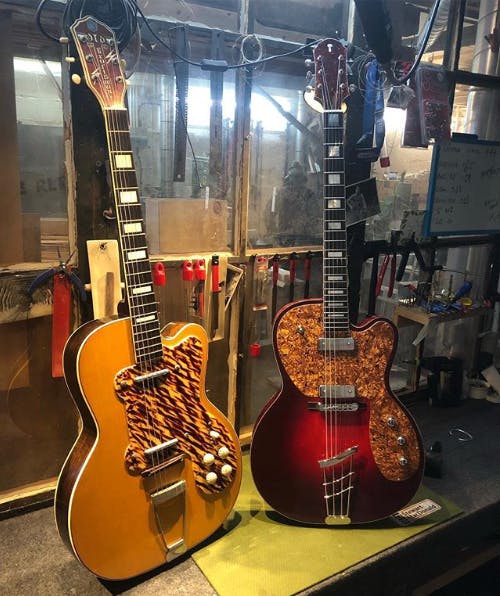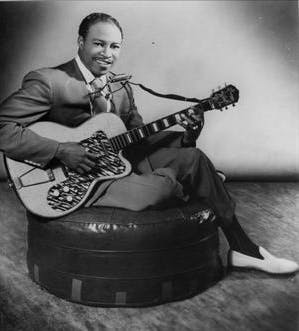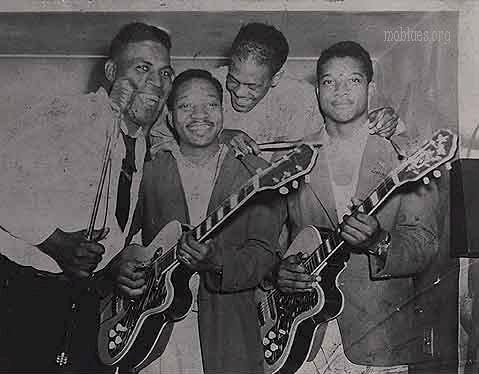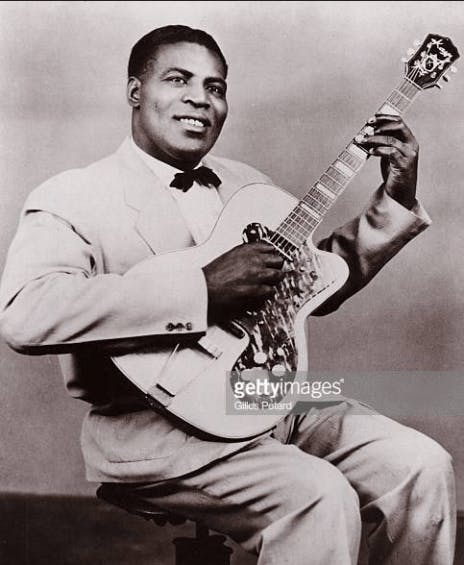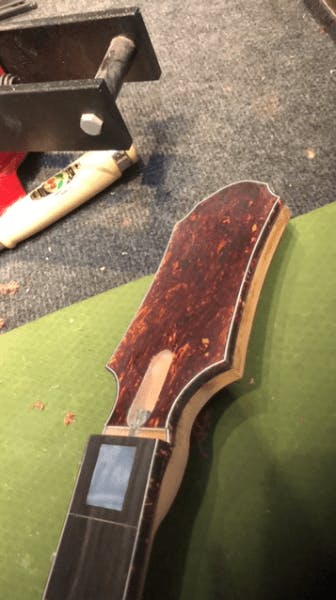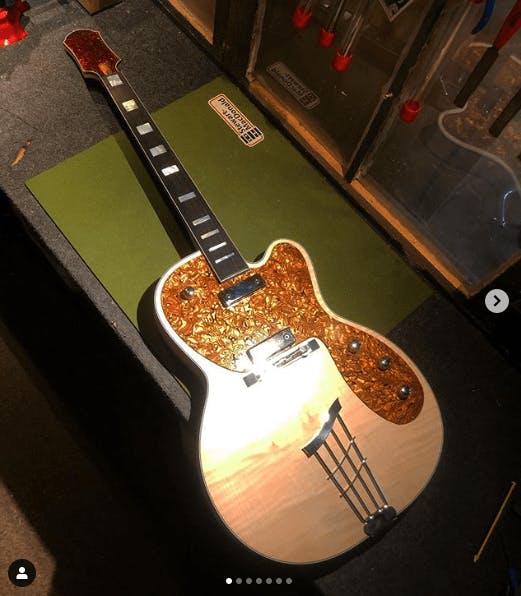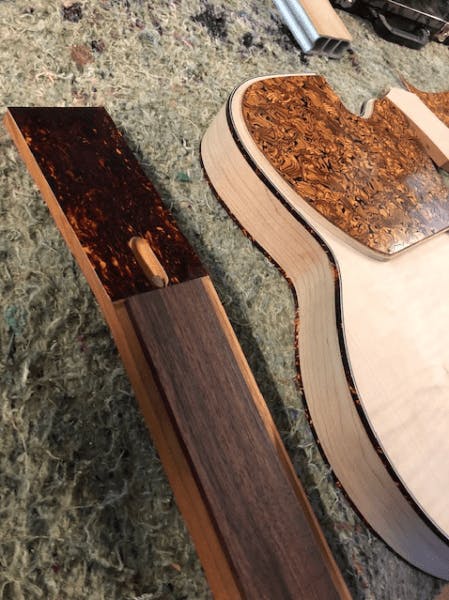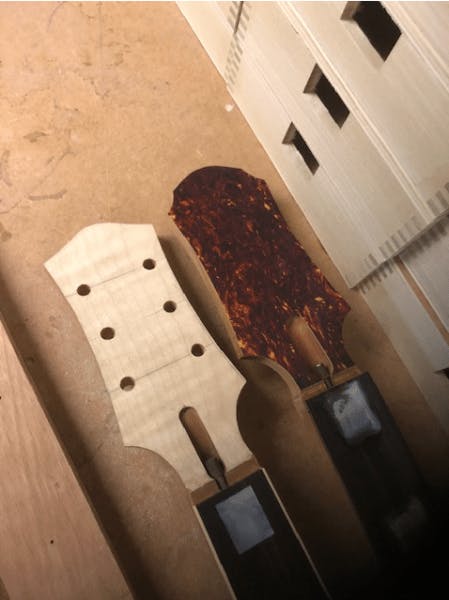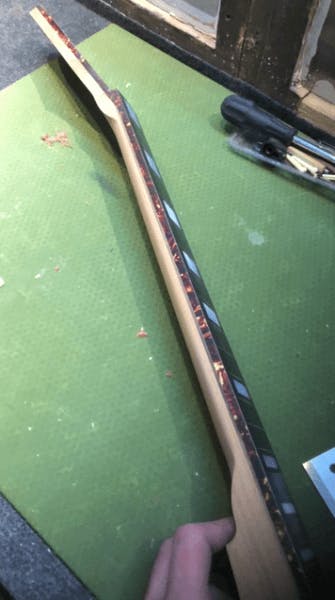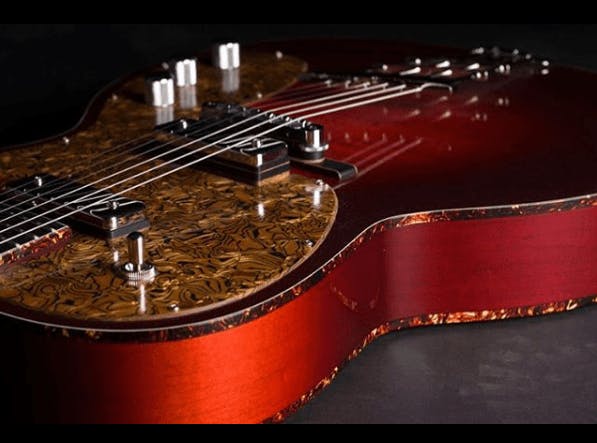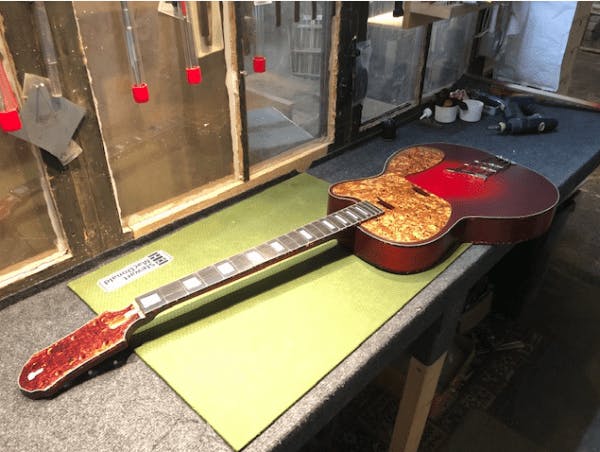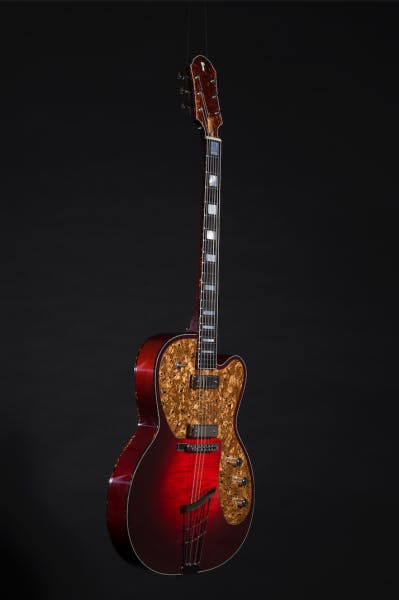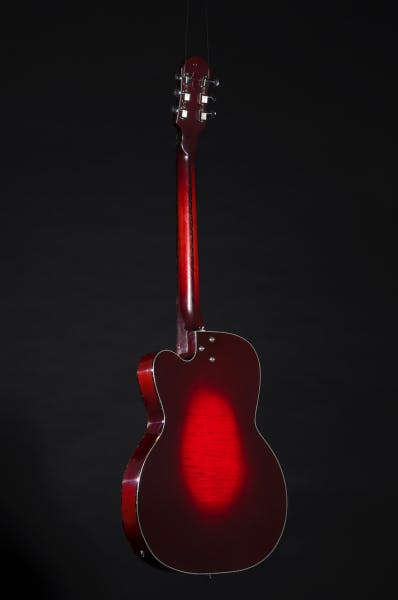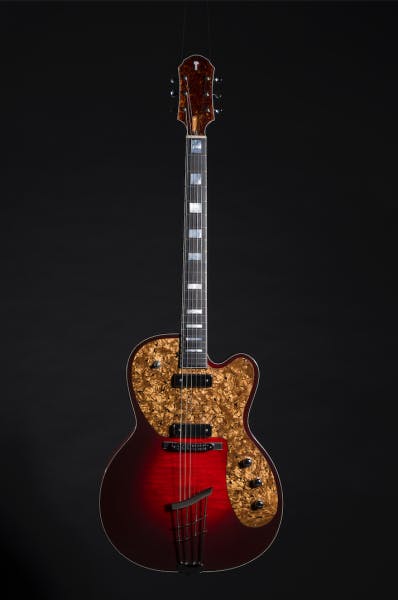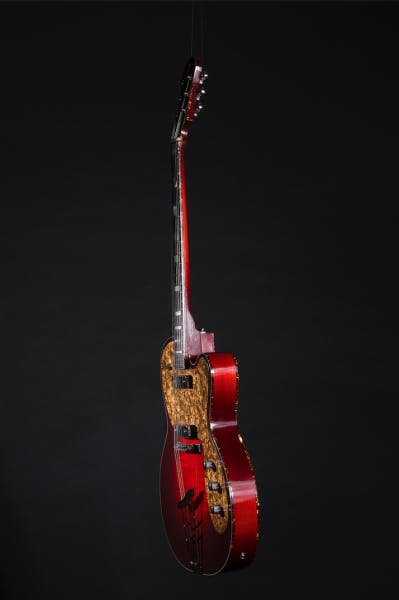A New Guitar Model with Distinct Lineage.
Posted: 2020-05-21
The Inspiration
For quite some time now I’ve been designing and developing a new guitar model with distinct lineage. Throughout my time crafting musical instruments (which admittedly isn’t long), and collecting vintage guitars I’ve been drawn to one guitar model in particular. My eyes light up every time I see a musician wielding this particular piece of wood and metal. I can’t explain what exactly it is that chimes with me. It rouses a kind of gear-geek syndrome. Somehow I can’t help but feel that a musician with one of these guitars in their arsenal must feel the way I do about it.
Rationality
By modern guitar terms its a rather vulgar styled, cumbersome lump of wood, rudimentary and even awkward. Yet it has a more profound effect on me than many of the boutique, high-end guitars I’m bombarded with everyday on Instagram. The front pages of glossy guitars magazines seem to endlessly be reviewing Strat/Tele/LP revisions. For some time I’ve toyed with the idea of designing (or rather redesigning) a new guitar model with distinct lineage. One guitar in particular comes to mind.
Background History
When one researches further into this particular guitar model you learn of its strange construction and the unusual materials used given the period it was first produced. A hollow body-style guitar with large Douglas fir centre-style twin block and twin single-coil pickups. Whereby effectively making it a hybrid semi-acoustic electric guitar (of sorts). It predated the Gibson ES-335 by ten years. This was also a catalogue/ department store-bought, economy electric guitar that came in many variations under a heap of different brand name compositions. It was therefore the choice of many establishing Chicago electric blues bands living hand-to-mouth and performing with whatever was accessible. This guitars heritage is therefore imbedded in the Blues music movement. Given its period of manufacture these facts arguably make it one of, if not ‘the’ original rock’n’roll electric guitar.
The guitar model in mind if you haven’t already guessed is the ‘Kay 161’ aka Kay ‘Thin Twin’ or Jimmy Reed/Howlin Wolf guitar. Named so for its two thin blade-like single coil pickups and the notable guitarist that popularised it..
Now I’ve played many originals and adore their look, feel and sound despite almost having to fight them to play. Their heavy weight hung around my neck, unwieldy flat-top and base-ball bat neck. It has ultra-sensitive microphonic pickups, made overuse of tortoiseshell celluloid throughout. It has a strangled-jangled tone played acoustically – which turns to sparkled cutting treble electrified! Unfortunately many remain in poor condition, poorly maintained or poorly made from the factory. Accompanied by being badly repaired, almost all were simply not made to last this length of time!
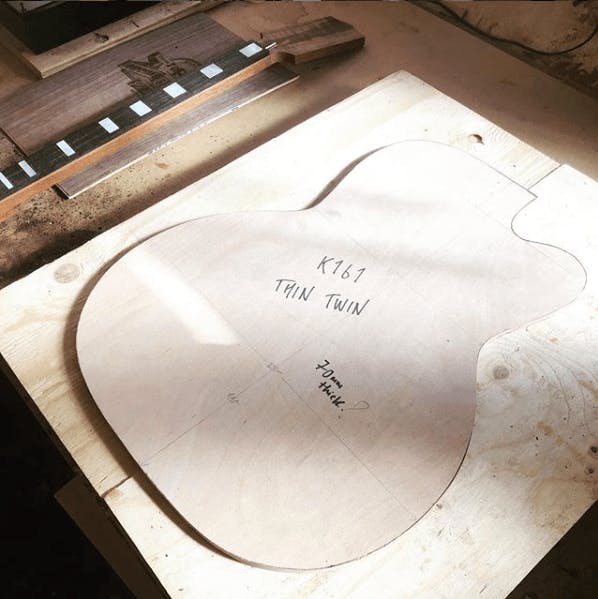
The Original
My ‘Old Kraftsman’ K161 from my private collection is in pretty perfect original condition. However it clearly was not constructed with a correct neck relief to give sufficient down-pressure on the wooden bridge. The strings pop out with hard plucking, the neck cannot be adjusted and the neck pickup is unusably ‘muddy’ to mention a few of its issues. All of which you would not expect to find on a modern electric guitar. Ive also had the opportunity to play a couple of the ‘reissue’ models made by Fritz Brothers. I commend their valiant effort at the ‘re-issue’, replicating the guitars construction as best possible. However to me a carbon-copy of this guitar is pointless – the original was timeless and flawed but perfectly imperfect. Instead a reincarnation for the modern guitarist is what I felt was due and what I felt I would like to attempt.

Elements to consider for me in making a new guitar model with distinct heritage like the K161 would be maintaining the original body shape (traced from my original model) and flat top. The composition would be with a large, over-sized pick guard made of a striking material. Perhaps heavy use of tortoiseshell celluloid, twin blade-like pickups and mid-century modern art deco style appointments.
I’d like someone who knew the original guitar to say to themselves ‘that reminds me of…’ and for someone who didn’t know it to think to themselves ‘that reminds me of …’ I wanted it to feel familiar enough but also feel fresh and exciting. Truly a modern vintage guitar model with distinct lineage.
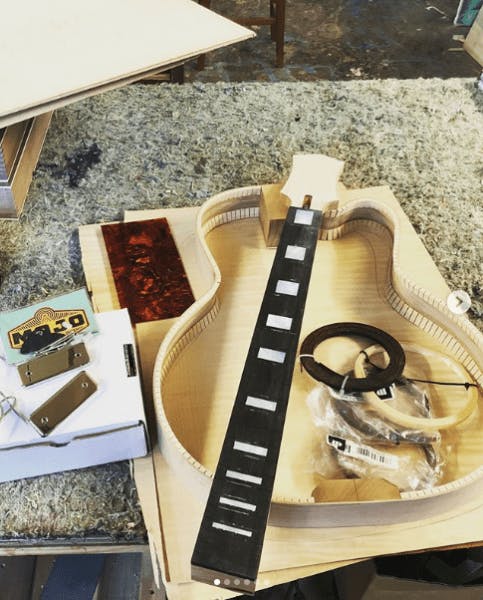
The Concept
To date my favourite vintage guitars are hollow-bodies (Kay, Harmony, Silvertone, Danelectro) and thus I would produce this model in a true hollow-body fashion with a centre-post beneath the bridge. it would have no f-holes like to original to reduce feedback. The hollow chamber would allow the pickups to combine internal micro-phonics as well as string motion for the tone. Maple steam bent rims, maple top and back, Honduran mahogany internal block, bracing, centre post and neck with Ebony fretboard and block mother-of-pearl inlays to remain true to the original.
Materials & Design
The original Kay made heavy use of tortoiseshell binding but my source for tortoiseshell celluloid didn’t produce tort/white/black configuration binding and thus I’d have to produce my own. I’d use 3-ply tort binding to accent the sides and neck, white being beneath the tort to make the colour inconsistencies really ‘pop’ (master luthier Alex Sorokin kindly gave his advice on what would look best for this). For the headstock I lifted the use of a tortoiseshell headstock overlay from the Harmony H77/78 which Ive always loved and mitred the binding to continue around the headstock profile. This method rather than using a ply tortoiseshell headstock overlay with bevelled edge to give the effect of a mitred binding.
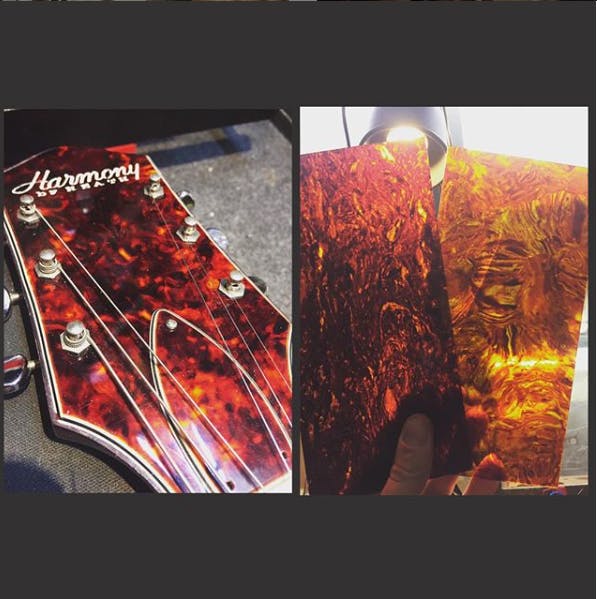

I needed a large piece of celluloid pick guard material and initially I desired the tiger-stripe similarly found on the original guitar. I’d seen a couple of other builders such a sDM Electrics,IslandandFrank Brosusing a similar material. However I couldn’t source a piece large enough for my pick guard pattern. I therefore decided on a striking alternative called tigers-eye/tiger-shell.
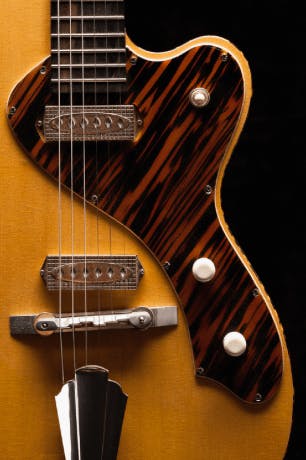

Hardware Considerations
Hardware wise I had a pair of Mojo Pickups single-coil ‘Hersey Bars’ made up to a similar spec as the originals. I decided on a two volume with single tone arrangement. Whereby when both pickups are selected the volumes effectively act like ‘blend controls’ between the pickup outputs. In addition a 3-way selector switch positioned top corner to space the controls ergonomically. I favour (like many vintage economy guitars) a floating bridge arrangement with trapeze tailpiece. However unlike the original my bridge would be tune-o-matic intonatable. I wanted to include my favourite vintage tailpiece ‘The Harp’ sourced especially from ABM in Germany. With the machine heads being my favourite for this period, that being Waverly closed-back ‘waffle’ tuners with chrome buttons.
Details
For pickup risers I decided to use Ebony/Maple to match the fretboard with lower section of ‘tigershell’ so as to appear to ‘blend’ with the pick guard. Similarly with the bridge base I used Ebony/Maple for the bulk with tortoiseshell lower-side sections to match the binding and give an overall ‘art-deco’ feel. Again a nod to the period when the original guitar was designed.
Final Specifications
For the neck I gave my typical ‘soft chunky V’ profile, 24.75″ scale which I feel works best. This accompanied by a 12″ radius of my neck width and set into the rear I inlayed a Rosewood ‘skunk stripe’. All to give it that true 50’s guitar feel.
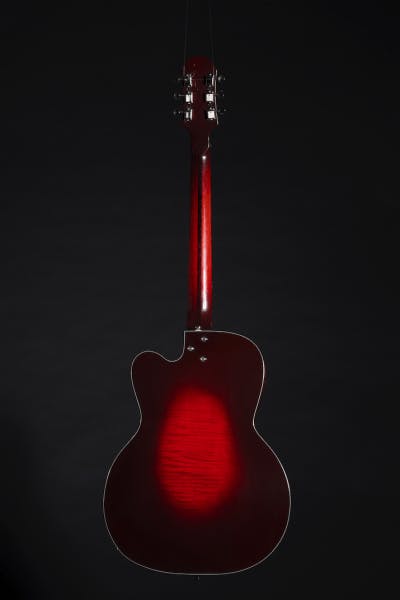
For the colour finish I settled on a three tone ‘heritage cherry’ burst (light/ heritage/ smoke) similar to that of the Harmony H78.Which I felt would work best with the tiger-shell/tigers-eye celluloid pick guard material I had sourced.
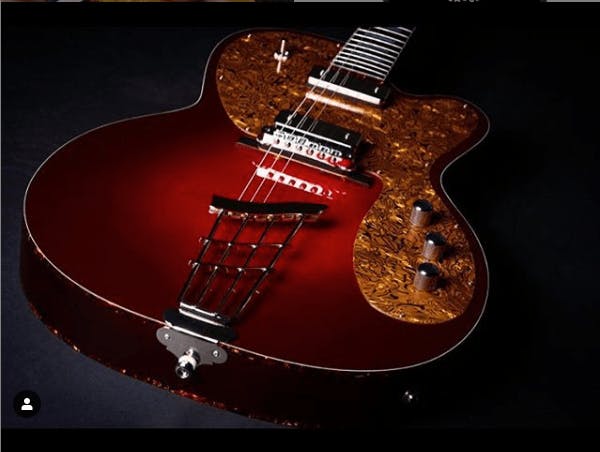
In all I’m very pleased with the final composition of the guitar model dubbed the Hammett ‘H161 ‘Slim Twin’ that so being because its thinner than the original in both neck and body dimensions – and sounds familiar like a new guitar model with distinct lineage. Hope y’all like it!
